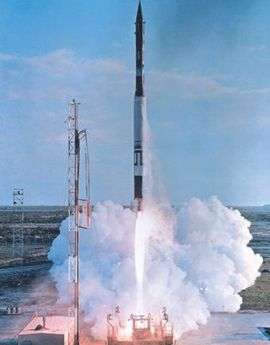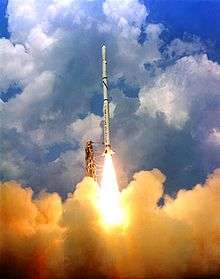Small-lift launch vehicle


A small-lift launch vehicle is a rocket orbital launch vehicle that is capable of lifting up to 2,000 kg (4,400 lb) of payload into low Earth orbit (LEO).[1]
The first small-lift launch vehicle was the Sputnik rocket, it put into orbit an unmanned orbital carrier rocket designed by Sergei Korolev in the Soviet Union, derived from the R-7 Semyorka ICBM. On 4 October 1957, the rocket was used to perform the world's first satellite launch, placing Sputnik 1 satellite into a low Earth orbit.[2][3][4] The USA responded by launching the Vanguard rocket,[5][6] that was intended to be the first launch vehicle the United States would use to place a satellite into orbit. Instead, the Sputnik crisis caused by the surprise launch of Sputnik 1 led the U.S., after the failure of Vanguard TV3, to quickly orbit the Explorer 1 satellite using a Juno I rocket launched on January 31, 1958. Vanguard I was the second successful U.S. orbital launch. Thus started the space race, that gave the drive to put men on the moon with the USA's Apollo program.[7][8]
It could be said the space race between United States and the Soviet Union started at the end of World War II, as a race began to retrieve as many V-2 rockets and Nazi Germany V-2 staff as possible.[9] Three hundred rail-car loads of V-2 rocket weapons and parts were captured and shipped to the United States, also 126 of the principal designers of the V-2, including Wernher von Braun and Walter Dornberger, went to America. Von Braun, his brother Magnus von Braun, and seven others decided to surrender to the United States military in Operation Paperclip to ensure they were not captured by the advancing Soviets or shot dead by the Nazis to prevent their capture.[10] Thus the V-2 program started the space race, the V-2 could not orbit, but could reach a height of 88 km (55 mi) on long range trajectory and up to 206 km (128 mi) if launched vertically.[11][12][13]
Small-lift launch vehicles
See also
- Sounding rocket non orbiting
- Medium-lift launch vehicle capable of lifting between 2,000 and 20,000 kg to low Earth orbit.
- Heavy lift launch vehicle capable of lifting between 20,000 and 50,000 kg to low Earth orbit.
- Super Heavy lift launch vehicles capable of lifting more than 50,000 kg (110,000 lb) of payload into LEO.
- Comparison of orbital launch systems
- Comparison of orbital rocket engines
- Comparison of space station cargo vehicles
- Rocket
- Spacecraft propulsion
References
- ↑ NASA Space Technology Roadmaps - Launch Propulsion Systems, p.11: "Small: 0-2t payloads, Medium: 2-20t payloads, Heavy: 20-50t payloads, Super Heavy: >50t payloads"
- ↑ NASA, Sputnik 1
- ↑ russianspaceweb.com Sputnik
- ↑ (Russian) Sputnik Rocket
- ↑ US Navy, Vanguard Project
- ↑ "The Vanguard Satellite Launching Vehicle — An Engineering Summary". B. Klawans. April 1960, 212 pages. Martin Company Engineering Report No 11022, PDF of an optical copy.
- ↑ Kennedy, John F. (April 20, 1961). "Memorandum for Vice President". The White House (Memorandum). Boston, MA: John F. Kennedy Presidential Library and Museum. Retrieved August 1, 2013.
- ↑ Launius, Roger D. (July 1994). "President John F. Kennedy Memo for Vice President, 20 April 1961" (PDF). Apollo: A Retrospective Analysis (PDF). Monographs in Aerospace History Number 3. Washington, D.C.: NASA. OCLC 31825096. Retrieved August 1, 2013. Key Apollo Source Documents.
- ↑ "We Want with the West", Time Magazine, 9 December 1946.
- ↑ "Wernher von Braun". Retrieved 2009-07-04.
- ↑ "Bumper Project". White Sands History - Fact Sheets and Articles. US Army. Archived from the original on 2008-01-10. Retrieved 2007-12-02.
- ↑ 'Long-range' in the context of the time. See NASA history article.
- ↑ Neufeld, Michael J (1995). The Rocket and the Reich: Peenemünde and the Coming of the Ballistic Missile Era. New York: The Free Press. pp. 158,160–2,190.
- ↑ astronautix.com, vanguard
- 1 2 3 4 5 6 7 8 "NISSAN HERITAGE COLLECTION online【その他】プリンス自動車工業小史". Nissan Motors. Retrieved 8 March 2011.
- 1 2 3 4 5 6 7 8 9 "Satellite Launch Vehicles". Institute of Space and Astronautical Science (ISAS). Retrieved 4 March 2011.
- ↑ "Launch Vehicles". Department of Space, Government of India. Retrieved 19 January 2014.
- ↑ jamejamonline.ir, Safir (rocket)
- ↑ "State television reports Iran launches satellite called 'Fajr' into space amid rocket tests". Fox Business. Retrieved 12 June 2015.
- 1 2 "Safir". Retrieved 2014-12-23.
- ↑ http://vectorspacesystems.com/technology-4
- ↑ Encyclopedia Astronautica, Black Arrow
- ↑ http://i004.radikal.ru/1508/a7/94ca7ddf9113.jpg
- ↑ Space Skyrocket STSAT 2C on Naro-1
- ↑ Space Skyrocket, kwangmyongsong-3 on a Unha
- ↑ irdt-1 Space Skyrocket on a Volna
- 1 2 3 "Vysota / Volna / Shtil". Retrieved 2014-12-23.
- ↑ astronautix.com Kaituozhe-1, also called KY-1
- ↑ Space Skyrocket, Aura (D 2B) on a Diamant
- ↑ Space Skyrocket, Diamant, retrieved 19 December 2015
- ↑ "NZ to get its own space programme by 2015". The New Zealand Herald. Retrieved 12 June 2015.
- ↑ http://vectorspacesystems.com/vectorh
- ↑ spacelaunchreport.com, Shavit Shavit-1 = 250, Shavit-2 = 300 LEO
- ↑ nasa.gov, NASA, Scout Launch Vehicle Program
- 1 2 Peláez, Javier. "PLD Space, la empresa española camino de lanzar satélites e incluso alcanzar la Luna". Yahoo noticias. Yahoo. Retrieved 19 April 2016.
- ↑ lanacion.com.ar, Tronador II
- ↑ Space Skyrocket, Shtil
- ↑ astronautix.com, Long March 1, also called CZ-1
- 1 2 3 "CZ-1". Gunter's Space Page. Retrieved 12 February 2014.
- ↑ "CZ-1". Astronautix.com. Retrieved 2013-11-04.
- ↑ Space Skyrocket, Explorer 49 RAE B
- 1 2 3 4 5 6 7 8 9 10 11 12 Gunter, Krebs. "Delta". Gunter's Space Page. Archived from the original on 2 August 2011. Retrieved 2 August 2011.
- ↑ NASA - National Space Science Data Center, NOAA 5 on a Delta 2310
- ↑ Space Skyrocket, GEOS 3-Delta 1410
- ↑ http://rocketcrafters.space/products-services/intrepid-launcher-family/intrepid-1/
- ↑ Space Skyrocket, VLS-1
- ↑ Aviation History, Explorer 47 on Delta 1604, Sept. 38, 1972
- 1 2 3 4 "Kuaizhou". Gunter's Space Pages. Retrieved 31 December 2014.
- ↑ Space Skyrocket, Falcon 1
- ↑ "Space Exploration Technologies Corporation - Falcon 1". Retrieved 2010-10-29.
- ↑ Parabolicarc.com, NASA Awards Launch for Orbital’s Pegasus Rocket, by Doug Messier, April 2, 2014
- 1 2 "Pegasus". Gunter's Space Pages. Retrieved 31 December 2014.
- ↑ Space Skyrocket, Sputnik 8K71PS
- ↑ fas.org Start1
- ↑ Space Skyrocket, EROS B on Start-1
- ↑ Space Skyrocket, Start-1
- ↑ "Minotaur I Space Launch Vehicle—Fact Sheet" (PDF). Orbital Sciences Corporation. 2012. Retrieved 2012-02-28.
Spacecraft mass-to-orbit of up to 580 kg to LEO (28.5 deg, 185 km)
- ↑ "Minotaur Space Launch Vehicles". Orbital Sciences Corporation. 2012. Retrieved 2012-08-28.
To date, Minotaur has conduced ten missions with a 100% success rate, delivering 33 satellites into orbit.
- ↑ "Minotaur IV Fact sheet" (PDF). Orbital Sciences Corporation. 2010. Retrieved 2009-03-04.
- 1 2 3 https://web.archive.org/web/20131204074139/http://www.orbital.com/SpaceLaunch/Minotaur/History/minotaur_history.shtml. Archived from the original on 4 December 2013. Retrieved 22 December 2015. Missing or empty
|title=(help) - 1 2 "Minotaur-C Factsheet" (PDF). Orbital Science Corporation. 2014.
- ↑ "Taurus / Minotaur-C". Gunter's Space Page. May 2014.
- ↑ https://web.archive.org/web/20140209053850/http://www.orbital.com/SpaceLaunch/Taurus/. Archived from the original on 9 February 2014. Retrieved 22 December 2015. Missing or empty
|title=(help) - ↑ China daily mail, China reveals CZ-11 anti-ASAT rocket, by chankaiyee2, October 8, 2015
- ↑ Barbosa, Rui. "China debuts Long March 11 lofting Tianwang-1 trio". NASASpaceFlight.com. Retrieved 2015-09-26.
- ↑ Korea, By Christoph Bluth,
- ↑ astronautix.com, Long March 1D -(CZ-1D
- ↑ Space Skyrocket Athena 1
- ↑ "Athena-1". Astronautix.com. Retrieved 2013-11-04.
- ↑ Space Skyrocket, Explorer: DE 1 and DE 2 on Delta 3913
- ↑ Japan Aerospace Exploration Agency, About J-I Launch Vehicle
- ↑ Space Skyrocket, OSO 8 satellite on Delta 1910
- ↑ astronautix.com, N-I- Delta
- ↑ Space Launch Report Atlas-Centaur
- ↑ Space Skyrocket, Atlas-Centaur
- 1 2 "Projects&Products". IHI Aerospace. Retrieved 2011-03-08.
- ↑ Wade, Mark. "Delta 0900". Encyclopedia Astronautica. Archived from the original on 2 August 2011. Retrieved 2 August 2011.
- 1 2 Gunter, Krebs. "Ariane-1, -2, -3, -4". Gunter's Space Page. Retrieved 2 August 2011.
- ↑ russianspaceweb.com Cosmos3
- ↑ Space Skyrocket Kosmos-3M
- ↑ russianspaceweb.com, Strela
- 1 2 "Strela". Gunter's Space Page. Retrieved 23 Dec 2014.
- ↑ space.skyrocket JERS (Fuyo) on a H-1
- ↑ NASA, Athena Mission Planner’s Guide 26 August 2012
- ↑ "Athena-2". Astronautix.com. Retrieved 2013-11-04.
- ↑ Space Skyrocket, Athena-2
- ↑ nasaspaceflight.com, Rokot, Russia’s Rokot launches with three Rodnik satellites, September 23, 2015, by Chris Bergin
- ↑ "Rokot (Rockot)". Gunter's Space Page. Retrieved 23 Dec 2014.
- ↑ "Rockot Launch Vehicle". Khrunichev.ru. Retrieved 2013-11-04.
Notes
Further reading
- Mallove, Eugene F. and Matloff, Gregory L. The Starflight Handbook: A Pioneer's Guide to Interstellar Travel, Wiley. ISBN 0-471-61912-4.